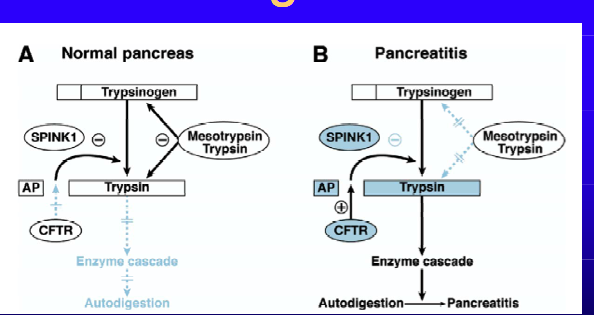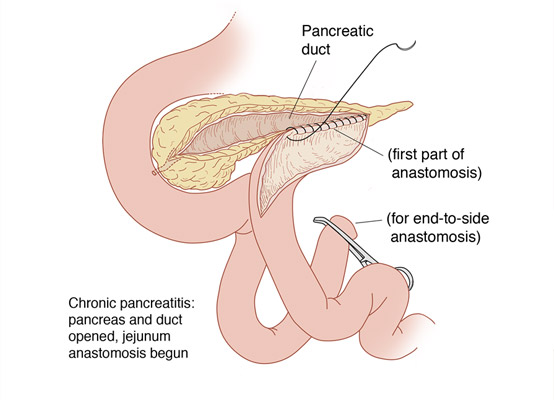The pancreas is a large gland behind the stomach and next to the small intestine. The pancreas does two main things:
- It releases powerful digestive enzymes into the small intestine to aid the digestion of food.
- It releases the hormones insulin and glucagon into the bloodstream. These hormones help the body control how it uses food for energy.
Pancreatitis is a disease in which the pancreas becomes inflamed. Pancreatic damage happens when the digestive enzymes are activated before they are released into the small intestine and begin attacking the pancreas.
There are two forms of pancreatitis: acute and chronic.
Acute pancreatitis. Acute pancreatitis is a sudden inflammation that lasts for a short time. It may range from mild discomfort to a severe, life-threatening illness. Most people with acute pancreatitis recover completely after getting the right treatment. In severe cases, acute pancreatitis can result in bleeding into the gland, serious tissue damage, infection, and cystformation. Severe pancreatitis can also harm other vital organs such as the heart, lungs, and kidneys.
Chronic pancreatitis. Chronic pancreatitis is long-lasting inflammationof the pancreas. It most often happens after an episode of acute pancreatitis. Heavy alcohol drinking is another big cause. Damage to the pancreas from heavy alcohol use may not cause symptoms for many years, but then the person may suddenly develop severe pancreatitis symptoms.
What Are the Symptoms of Pancreatitis?
Symptoms of acute pancreatitis:
- Upper abdominal pain that radiates into the back; it may be aggravated by eating, especially foods high in fat.
- Swollen and tender abdomen
- Nausea and vomiting
- Fever
- Increased heart rate
The symptoms of chronic pancreatitis are similar to those of acute pancreatitis. Patients frequently feel constant pain in the upper abdomen that radiates to the back. In some patients, the pain may be disabling. Other symptoms are weight loss caused by poor absorption (malabsorption) of food. This malabsorption happens because the gland is not releasing enough enzymes to break down food. Also, diabetes may develop if the insulin-producing cells of the pancreas are damaged.
What Causes Pancreatitis?
In most cases, acute pancreatitis is caused by gallstones or heavy alcohol use. Other causes include medications, infections, trauma, metabolic disorders, and surgery. In up to 15% of people with acute pancreatitis, the cause is unknown.
In about 70% of people, chronic pancreatitis is caused by long-time alcohol use. Other causes include gallstones, hereditary disorders of the pancreas, cystic fibrosis, high triglycerides, and certain medicines. In about 20% to 30% of cases, the cause of chronic pancreatitis is unknown.

What Are the Risk Factors for Pancreatitis?
Pancreatitis can happen to anyone, but it is more common in people with certain risk factors.
Risk factors of acute pancreatitis include:
- Gallstones
- Heavy alcohol drinking
Acute pancreatitis may be the first sign of gallstones. Gallstones can block the pancreatic duct, which can cause acute pancreatitis.
Risk factors for chronic pancreatitis include:
- Heavy alcohol drinking for a long time
- Certain hereditary conditions, such as cystic fibrosis
- Gallstones
- Conditions such as high triglycerides and lupus
People with chronic pancreatitis are usually men between ages 30 and 40, but chronic pancreatitis also may occur in women.
How Is Pancreatitis Diagnosed?
To diagnose acute pancreatitis, doctors measure levels in the blood of two digestive enzymes, amylase and lipase. High levels of these two enzymes strongly suggest acute pancreatitis.
Doctors may also use other tests, such as:
- Pancreatic function test to find out if the pancreas is making the right amounts of digestive enzymes
- Glucose tolerance test to measure damage to the cells in the pancreas that make insulin
- Ultrasound, CT scan, and MRI, which make images of the pancreas so that problems may be seen
- ERCP to look at the pancreatic and bile ducts using X-rays
- Biopsy, in which a needle is inserted into the pancreas to remove a small tissue sample for study
How Is Pancreatitis Treated?
Treatment for acute pancreatitis
People with acute pancreatitis are typically treated with IV fluids and pain medications in the hospital. In some patients, the pancreatitis can be severe and they may need to be admitted to an intensive care unit (ICU). In the ICU, the patient is closely watched because pancreatitis can damage the heart, lungs, or kidneys. Some cases of severe pancreatitis can result in death of pancreatic tissue. In these cases, surgery may be necessary to remove the dead or damaged tissue if an infection develops.
An acute attack of pancreatitis usually lasts a few days. An acute attack of pancreatitis caused by gallstones may require removal of the gallbladder or surgery of the bile duct. After the gallstones are removed and the inflammation goes away, the pancreas usually returns to normal.
Treatment for chronic pancreatitis
Chronic pancreatitis can be difficult to treat. Doctors will try to relieve the patient’s pain and improve the nutritionproblems. Patients are generally given pancreatic enzymes and may need insulin. A low-fat diet may also help.


Post a comment